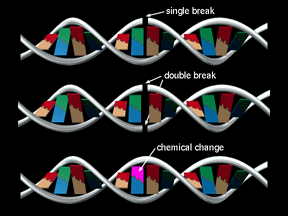This simple cartoon shows general similarities and differences between eukaryote and prokaryote cells.
Click on image for full size
Image courtesy of Windows to the Universe
Cells: The Building Blocks of Life!
The Cell Theory states that all living things are made of cells, which are the basic units of life, and that cells come from other cells.
Prokaryotic cells have no nucleus or organelles enclosed within membranes. Species in the domains Archaea and Eubacteria have prokaryotic cells.
Eukaryotic cells have a nucleus and organelles that are surrounded by membranes. Each organelle does a specific cell function. All species in the Eukaryota domain (protists, fungi, plants, and animals) have eukaryotic cells. Individual protists are small and have only one cell, while individual plants and animals can have trillions of cells. Complex creatures like humans have special cells for particular functions such as carrying oxygen around the body, digesting food, or making bone.
One theory about how cells originally formed states that the first life on Earth consisted of several types of tiny, simple prokaryotic cells. Over time, prokaryotes with different specializations became engulfed within larger prokaryotes. This was beneficial to both the larger prokaryotes who were able to perform more functions with help from the smaller ones trapped within and the smaller prokaryotes who were protected within the larger one. Over millions of years the smaller prokaryotes became the organelles within eukaryotic cells.
You might also be interested in:

Eubacteria, also know as “true bacteria”, are microscopic organisms that have prokaryotic cells. Because of their prokaryotic cells, they have a rigid cell wall but no mitochondria or other large organelles,
...more
Scientists use the word theory differently than nonscientists. "It’s just a theory," you hear people say. When speaking casually, people often use the word "theory" to mean a "guess" or a "feeling". In
...more
Earth's first life form may have developed between the layers of a chunk of mica sitting like a multilayered sandwich in primordial waters, according to a new hypothesis. The mica hypothesis, which was
...more
Whether or not a cell can repair itself after being damaged by radiation depends on the type of damage to the cell's DNA. Type of Damage Prospects for DNA Repair Single strand break in the DNA Can usually
...more
High frequency radiation or fast moving particles plow into a living cell with enough energy to knock electrons free from molecules that make up the cell. These molecules with missing electrons are called
...more
Talking fish are no strangers to Americans. From the comedic portrayal of "Mr. Limpet" by Don Knotts, to the children's Disney favorite, "Nemo," fish can talk, laugh and tell jokes--at least on television
...more
Radiation can be harmful to living creatures. Radiation can harm living things directly by damaging their cells. The cells might stop functioning, or they might be unable to reproduce. Radiation can also
...more














